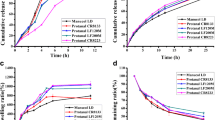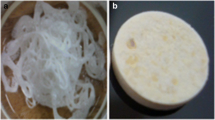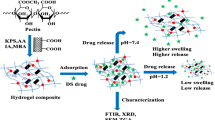Abstract
Currently, polysaccharide-based hydrogels are widely studied macromolecular networks to modify drug dissolution from controlled-releasing matrix tablets. Among them, polyelectrolyte complexes (PEC) films consisted of chitosan (CS) and sodium alginate (SA) could be obtained via spontaneously assembling under physiological gastrointestinal environment. Here, we utilized these self-assembled PEC films as an efficient coating materials to develop controlled-released matrix tablets through compression coating process, with paracetamol (APAP) as model drug. The constitutive and morphology characteristic studies on these PEC films illustrated that the mixture of CS and SA with the weight ratio of 1:1 would be an promising outer layer for compression-coating tablets. In addition, the in vitro drug releasing behavior experiments demonstrated that the optimized compression coating tablets displayed satisfied zero-order drug releasing profits. Furthermore, the in vivo pharmacokinetic studies of these APAP loaded compression-coated tablets in New Zealand rabbits gave that the Tmax (12.32 ± 1.05 h) was significantly prolonged (p < 0.01), compared to that (0.89 ± 0.26 h) of common APAP tablets (Jinfuning®) after oral administration. These studies suggest that the compression-coated tablets with self-assembled PEC film as coating outer layer may be a promising strategy for peroral controlled release delivery system of water soluble drugs.
Graphical Abstract








Similar content being viewed by others
References
Peppas NA. Hydrogels in medicine and pharmacy polymers. II. Boca Raton, FL: CRC Press; 1987. p. 184
Coviello T, Matricardi P, Marianecci C, Alhaique F. Polysaccharide hydrogels for modified release formulations. J Control Release. 2007;119(1):5–24. doi:10.1016/j.jconrel.2007.01.004
Berger J, Reist M, Mayer JM, Felt O, Gurny R. Structure and interactions in chitosan hydrogels formed by complexation or aggregation for biomedical applications. Eur J Pharm Biopharm. 2004;57(1):35–52. doi:10.1016/s0939-6411(03)00160-7
George M, Abraham TE. Polyionic hydrocolloids for the intestinal delivery of protein drugs: alginate and chitosan—a review. J Control Release. 2006;114(1):1–14. doi:10.1016/j.jconrel.2006.04.017
Bhattarai N, Gunn J, Zhang M. Chitosan-based hydrogels for controlled, localized drug delivery. Adv Drug Deliv Rev. 2010;62(1):83–99. doi:10.1016/j.addr.2009.07.019
Kim JH, Ramasamy T, Tran TH, Choi JY, Cho HJ, Yong CS, et al. Polyelectrolyte complex micelles by self-assembly of polypeptide-based triblock copolymer for doxorubicin delivery. Asian J Pharm Sci. 2014;9(4):191–8. doi:10.1016/j.ajps.2014.05.001
Wu QX, Zhang QL, Lin DQ, Yao SJ. Characterization of novel lactoferrin loaded capsules prepared with polyelectrolyte complexes. Int J Pharm. 2013;455(1-2):124–31. doi:10.1016/j.ijpharm.2013.07.048
Zhang T, Mao S, Sun W. Design and in vitro evaluation of a film-controlled dosage form self-converted from monolithic tablet in gastrointestinal environment. J Pharm Sci. 2010;99(11):4678–90. doi:10.1002/jps.22163
Waterman KC, Fergione MB. Press-coating of immediate release powders onto coated controlled release tablets with adhesives. J Control Release. 2003;89(3):387–95. doi:10.1016/s0168-3659(03)00132-9
Picker KM. Influence of tableting on the enzymatic activity of different [alpha]-amylases using various excipients. Eur J Pharm Biopharm. 2002;53:181–5.
Lopes CM, Sousa Lobo JM, Pinto JF, PC C. Compressed matrix coretablet as a quick/slow dual-component delivery system containing ibuprofen. AAPS PharmSciTech. 2007;8:195–202.
Siepe S, Lueckel B, Kramer A, Ries A, Gurny R. Strategies for the design of hydrophilic matrix tablets with controlled microenvironmental pH. Int J Pharm. 2006;316(1-2):14–20. doi:10.1016/j.ijpharm.2006.02.021
Qi X, Chen H, Rui Y, Yang F, Ma N, Wu Z. Floating tablets for controlled release of ofloxacin via compression coating of hydroxypropyl cellulose combined with effervescent agent. Int J Pharm. 2015;489(1-2):210–7. doi:10.1016/j.ijpharm.2015.05.007
Tarvainen M, Sutinen R, Peltonen S, Mikkonen H, Maunus J, Vähä-Heikkilä K, et al. Enhanced film-forming properties for ethyl cellulose and starch acetate using n-alkenyl succinic anhydrides as novel plasticizers. Eur J Pharm Biopharm. 2003;19(5):363–71. doi:10.1016/s0928-0987(03)00137-4
Rekhi GS, Jambhekar SS. Ethylcellulose—a polymer review. Drug Dev Ind Pharm. 1995;21(1):61–77. doi:10.3109/03639049509048096
Pani NR, Nath LK. Development of controlled release tablet by optimizing HPMC: consideration of theoretical release and RSM. Carbohydr Polym. 2014;104:238–45. doi:10.1016/j.carbpol.2014.01.037
Nakano M, Ohmori N, Ogata A, Sugimoto K, Tobino Y, Iwaoku R, et al. Sustained release of theophylline from hydroxypropylcellulose tablets. J Pharm Sci. 1983;72(4):378–80. doi:10.1002/jps.2600720414
Vandelli MA, Leo E, Foni F, Bernabei MT. Drug release from perforated matrices containing hydroxypropylcellulose. Int J Pharm. 1998;171(2):165–75. doi:10.1016/S0378-5173(98)00208-7
Nakano M, Ohmori N, Ogata A, Sugimoto K, Tobino Y, Iwaoku R, et al. Sustained release of theophylline from hydroxypropylcellulose tablets. J Pharm Sci. 1983;72:378–80. doi:10.1208/s12249-015-0359-0
Tavakol M, Vasheghani-Farahani E, Dolatabadi-Farahani T, Hashemi-Najafabadi S. Sulfasalazine release from alginate-N,O-carboxymethyl chitosan gel beads coated by chitosan. Carbohyd Polym. 2009;77(2):326–30. doi:10.1016/j.carbpol.2009.01.005
Motwani SK, Chopra S, Talegaonkar S, Kohli K, Ahmad FJ, Khar RK. Chitosan-sodium alginate nanoparticles as submicroscopic reservoirs for ocular delivery: formulation, optimisation and in vitro characterisation. Eur J Pharm Biopharm. 2008;68(3):513–25. doi:10.1016/j.ejpb.2007.09.009
Luo Y, Wang Q. Recent development of chitosan-based polyelectrolyte complexes with natural polysaccharides for drug delivery. Int J Biol Macromol. 2014;64:353–67. doi:10.1016/j.ijbiomac.2013.12.017
Rawlins MD, Henderson DB, Hijab AR. Pharmacokinetics of paracetamol (acetaminophen) after intravenous and oral administration. Eur J Clinical Pharm. 1977;11:283–6.
Obeidat WM, Nokhodchi A, Alkhatib H. Evaluation of matrix tablets based on Eudragit(R)E100/Carbopol(R)971P combinations for controlled release and improved compaction properties of water soluble model drug paracetamol. AAPS PharmSciTech. 2015;16(5):1169–79. doi:10.1208/s12249-015-0301-5
Tadros MI. Controlled-release effervescent floating matrix tablets of ciprofloxacin hydrochloride: development, optimization and in vitro-in vivo evaluation in healthy human volunteers. Eur J Pharm Biopharm. 2010;74(2):332–9. doi:10.1016/j.ejpb.2009.11.010
Donbrow M, Samuelov Y. Zero order drug delivery from double-layered porous films: release rate profiles from ethyl cellulose, hydroxypropyl cellulose and polyethylene glycol mixtures. J Pharm Pharmacol. 1980;32:463–70
Ritger PL, Peppas NA. A simple equation for description of solute release.II. Fickian and anomalous release from swellable devices. J Control Release. 1987;5:37–42
Zhang C, Xu M, Tao X, Tang J, Liu Z, Zhang Y, et al. A floating multiparticulate system for ofloxacin based on a multilayer structure: in vitro and in vivo evaluation. Int J Pharm. 2012;430(1-2):141–50. doi:10.1016/j.ijpharm.2012.04.013
Conti S, Maggi L, Segale L, Ochoa Machiste E, Conte U, Grenier P, et al. Matrices containing NaCMC and HPMC 2. Swelling and release mechanism study. Int J Pharm. 2007;333(1-2):143–51. doi:10.1016/j.ijpharm.2006.11.067
Huanbutta K, Terada K, Sriamornsak P, Nunthanid J. Advanced technologies for assessment of polymer swelling and erosion behaviors in pharmaceutical aspect. Eur J Pharm Biopharm. 2013;83(3):315–21. doi:10.1016/j.ejpb.2012.10.002
Maderuelo C, Zarzuelo A, Lanao JM. Critical factors in the release of drugs from sustained release hydrophilic matrices. J Control Release. 2011;154(1):2–19. doi:10.1016/j.jconrel.2011.04.002
Bueno CZ, Moraes ÂM, de Sousa HC, Braga MEM. Effects of supercritical carbon dioxide processing on the properties of chitosan–alginate membranes. J Supercrit Fluid. 2016;112:128–35. doi:10.1016/j.supflu.2015.10.001
Takahashi T, Takayam K, Machida Y, Nagai T. Characteristics of polyion complexes of chitosan with sodium alginate and sodium polyacrylate. Int J Pharm. 1990;61:35–41. doi:10.1016/j.jconrel.2015.05.271
Korsmeyer RW, Gurny R, Doelker E, Buri P, Peppas NA. Mechanisms of potassium chloride release from compressed, hydrophilic, polymeric matrices: effect of entrapped air. J Pharm Sci. 1983;72:1189–91. doi:10.1016/j.ijbiomac.2015.03.024
Yamaoka K, Tanigawara Y, Nakagawa T, Uno T. A pharmacokinetic analysis program (multi) for microcomputer. J Pharmacobiodyn. 1981;4:879–85. doi:10.1016/j.ijpharm.2010.09.021
Acknowledgements
This work was financially supported by the National Natural Science Foundation of China (No. 81402859).
Author information
Authors and Affiliations
Corresponding authors
Ethics declarations
Conflict of interest
The authors declare that they have no conflict of interest.
Rights and permissions
About this article
Cite this article
Li, W., Huo, M., Sen Chaudhuri, A. et al. Self-assembled polyelectrolyte complexes films as efficient compression coating layers for controlled-releasing tablets. J Mater Sci: Mater Med 28, 67 (2017). https://doi.org/10.1007/s10856-017-5886-7
Received:
Accepted:
Published:
DOI: https://doi.org/10.1007/s10856-017-5886-7




